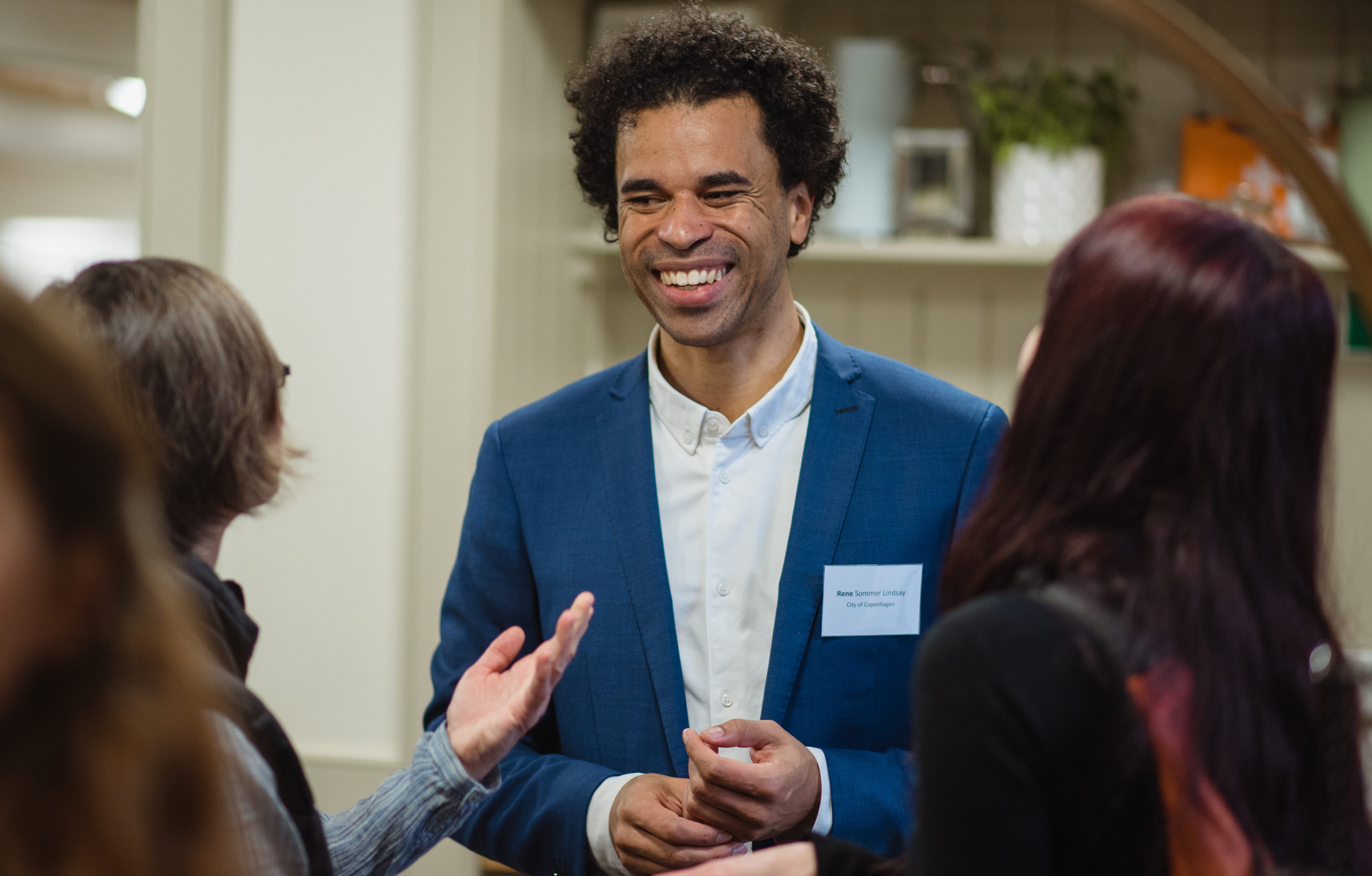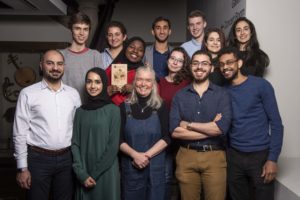Edinburgh Adapts: ambition to action

Edinburgh Adapts is a collaboration between The Edinburgh Partnership, Adaptation Scotland, and Sniffer, and aims to help the city adapt to the challenges of a changing climate. David Macpherson reports on the initiative’s latest event which the University of Edinburgh took part in.
On a rather wet 4 April 2018, Edinburgh Adapts welcomed a lively crowd of representatives from across the city, and some international guests, to our ‘Ambition to Action’ seminar. The aim of the day was to reflect and build on the early successes of the Edinburgh Adapts Action Plan, and continue to build momentum and relationships that will help us achieve the bold vision of a climate ready capital. Hosted in the historic surrounds of the newly restored Botanic Cottage, both the oldest and newest building at the Royal Botanic Garden Edinburgh, the scene was set for an inspiring day of presentations, planning and discussion.
Welcome
 The Regius Keeper of the Royal Botanic Garden Edinburgh, Simon Milne, set ball rolling with a warm welcome to the Garden and reflections on how climate change was already leading to big changes in plant health and distribution both here in Scotland and around the world. As temperatures increase and conditions change, ecological networks are being put under significant stress, reinforcing the need for the valuable research, conservation and educational work the Garden has been doing since 1699. But never has the rate of change been as fast as it is now. As Simon explained, the challenges are great, and while ambition is essential, the test is delivering action before it’s too late.
The Regius Keeper of the Royal Botanic Garden Edinburgh, Simon Milne, set ball rolling with a warm welcome to the Garden and reflections on how climate change was already leading to big changes in plant health and distribution both here in Scotland and around the world. As temperatures increase and conditions change, ecological networks are being put under significant stress, reinforcing the need for the valuable research, conservation and educational work the Garden has been doing since 1699. But never has the rate of change been as fast as it is now. As Simon explained, the challenges are great, and while ambition is essential, the test is delivering action before it’s too late.
Progress and ambition
Our first round of presentations focused on this ambition. Councillor Neil Gardiner, Convenor of the Planning Committee at the City of Edinburgh Council, reflected on the progress achieved by Edinburgh Adapts in its first year: over 100 actions in the Action Plan and most already underway, showcasing the story of Edinburgh Adapts at the highest international levels, including COP23 and the European Climate Change Adaptation Conference, and a strong foundation of committed partner organisations ready to take the next steps. His challenge to the audience was to take this momentum and use it to go even further.

This call to action was echoed by Phil McNaull, Director of Finance at the University of Edinburgh. He explained the mission of the University is to change the world for the better, and that adapting to climate change is a big part of that mission. Reflecting on the recent period of heavy snowfall, when the University was forced to close for two days, Phil explained finance teams and the financial sector is increasingly taking notice of the impacts of the climate on the bottom line. Having the figures for the costs of recent weather based disruptions can really help make the business case for adaptation action. But, as many of our speakers were to reflect throughout the day, people’s attitudes and behaviours are rarely changed by facts and figures alone. We need to tell the stories of climate change in ways that move people to see their stake in the cause and change their behaviour.
The importance of these emotional and cultural perspectives was echoed by Alison Turnbull, Director of Development and Partnerships at Historic Environment Scotland (HES). The historic character of Edinburgh, and Scotland as a whole, is an essential component of both the stories we tell ourselves and the reasons people from around the world come to visit Old Reekie in increasing numbers. The historic environment is a shared resource which can best be protected and promoted through sharing the task of looking after it, as was demonstrated by the partnership team who delivered HES’s recent Climate Change Physical Risk Assessment, and in their collaborations with Edinburgh World Heritage on its new management plan and beyond. The is a role for all to play in protecting Edinburgh’s historic reputation from climate change, with actions as simple as arranging a roof inspection to as large as HES’s work to install a rockfall barrier underneath Edinburgh Castle all combining to make our city climate ready.
From the character of Edinburgh, to the character of our own species, Jonny Hughes, Chief Executive of the Scottish Wildlife Trust, opened his presentation by revealing Homo Sapiens is now a predominately urban animal. With urban populations around the world set to grow exponentially in the coming decades, if we want to retain a connection to nature in our daily lives, we need to invite it in and make our home a home for all. The good news is that there are great benefits from such an approach. Increasingly urban planners are realising nature is not a problem to be fixed, but an ally and solution to many of modern life’s most pressing issues. Green Infrastructure can not only increase our resilience to climate change impacts, it can do so while improving our health and wellbeing, reducing stress, encouraging nature, and opening up new economic opportunities. But to secure these benefits, like nature, we need to be connected. Initiatives like Edinburgh Adapts and Edinburgh Living Landscape, and the multitude of grass-roots projects throughout the city, can bring this connection so people can work together for shared goals.
Leading action
After a quick break for coffee and tea, we launched into action with four quick fire case study presentations on work already underway by Edinburgh Adapts partners.

Dave Gorman, Director of Social Responsibility and Sustainability at the University of Edinburgh, showed how taking a whole institution approach to creating their new climate plan allowed the university to draw on the considerable expertise and talents of students and staff. His advice for gaining the buy-in of senior colleagues was to find out what ‘good’ is for your sector and how your organisation’s performance compares with its peers. If you’re already the best, they’ll want to stay that way, and if you’re not the best, they’ll want to know how they can be.
Mairi Davis, Climate Change Manager at Historic Environment Scotland, set out four common reasons traditional buildings can be vulnerable to the whim of the weather. Poor maintenance, the removal or damage of functional details, unsuitable repairs and reduced ventilation (often exacerbated by blocked up redundant chimneys), can all lead to damage to structures. But the good news is many of these issues are relatively easy to fix, provided you have access to the right skills and materials. Luckily, HES is helping to make sure those skills continue to be taught through new training facilities and opportunities provided at the Engine Shed in Stirling.
It was then over to Fiona MacLeod, Senior Policy Officer at the City of Edinburgh Council, to turn our attention to Edinburgh’s coast. A coastline that is 70% artificial and a natural orientation towards the city centre means Edinburgh often doesn’t portray itself as a coastal city. But with climate change causing rising sea levels and creating challenges conditions for marine environments, adaptation of the coast could be a way to both protect our homes and businesses, and restore a more natural border with the sea. To support this work, an Edinburgh version of the National Coastal Change Assessment could help increase understanding of where interventions can best be made, while the year-long Edinburgh Shorelines project aims to develop a set of aspiration visions for what our city’s coast could be.
And more re-imagining has been going on in the Botanic Garden and in North Edinburgh thanks in part to Edinburgh Adapts, as Ruth Monfries, Leonie Alexander, and David Kelly explained. Work is progressing to create a new rain garden within the Botanic Garden to help alleviate surface water flooding and showcase green infrastructure in action. At the same time, the issue of surface water flooding was the inspiration for a bold pilot project in the Granton area which encouraged local residents tell stories about how their area may change in the future and used these future fictions to re-imagine a prominent local street as an exemplar climate adapted neighbourhood.
International perspective – insights for Edinburgh’s possible future
 Throughout the day, René Sommer Lindsay, Special Advisor on Climate Change Adaptation for the City of Copenhagen, took on the role of key note listener and as the rain began to ease he was ready to show us what his city had been able to achieve when faced with the climate challenge.
Throughout the day, René Sommer Lindsay, Special Advisor on Climate Change Adaptation for the City of Copenhagen, took on the role of key note listener and as the rain began to ease he was ready to show us what his city had been able to achieve when faced with the climate challenge.In July 2011, Copenhagen discovered the scale of damage and disruption climate change could bring when a cloudburst rapidly flooded large parts of the city. René explained how what started as a disaster quickly became a curiosity, with citizens going out in the rain to watch their city change before their eyes, and then, through lots of hard work and dialogue, was transformed into an opportunity. This idea of a city that changes with the weather was incorporated into the development of Copenhagen’s Climate Change Adaptation Plan and put into practise in a number of pilot sites under the banner of Klimakvarter.
The pilot projects combined innovative design and water management, with lots of creative engagement events to get local residents interested in adapting their city, including an ‘Instant Hygge’ conversation café, art installations and a rooftop farm built on top of a parking garage that become a cultural destination and even grew its own restaurant. All this was achieved while increasing flood protection and protecting water quality. And this is just the start, with the pilot projects the first steps in a 20 year plan to transform the city.
Reflecting on progress so far, René drew on many similar themes to the other speakers: emphasising the essential need to work in partnership with other organisations; recognising that working together requires constant dialogue and considered compromise; capturing stories as well as collecting data, and using these stories to motivate action and celebrate success; and the importance of building projects with citizens rather than for them.
All photographs copyright of Historic Environment Scotland.





Recent comments